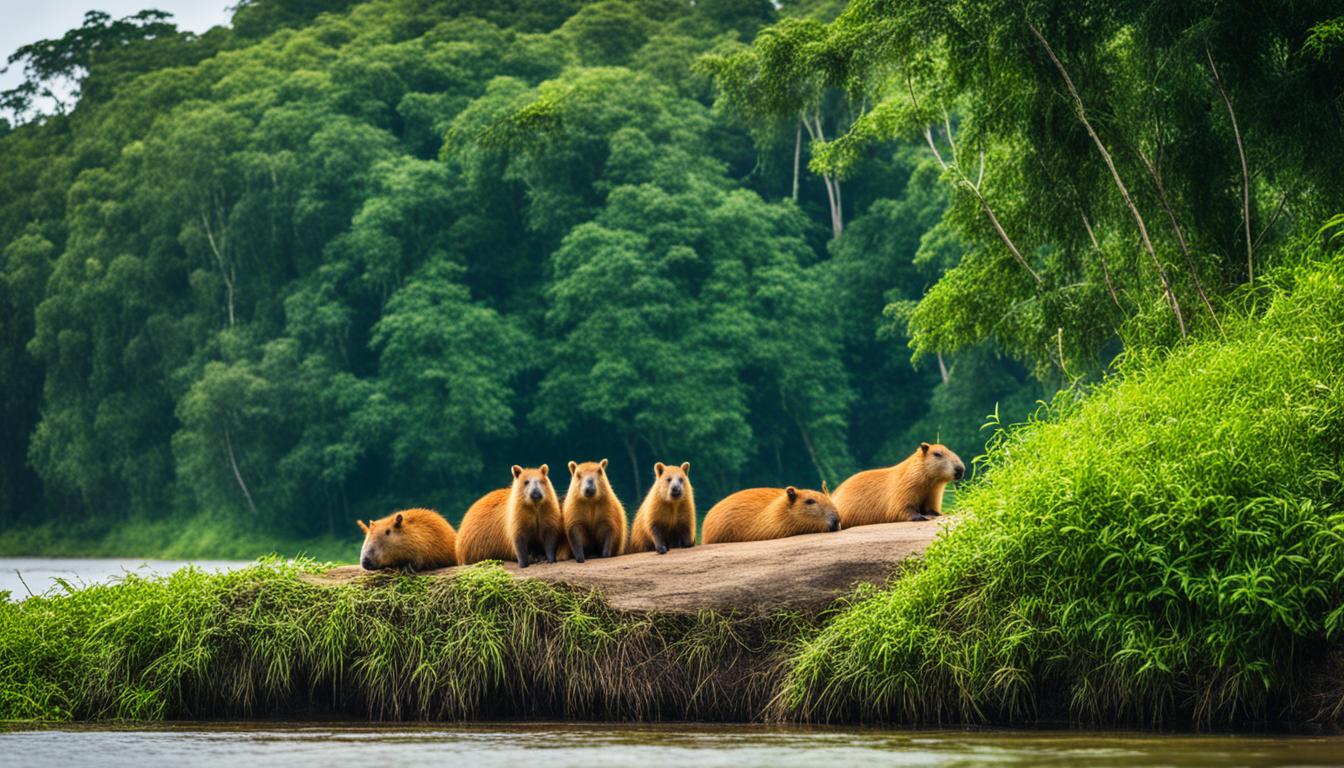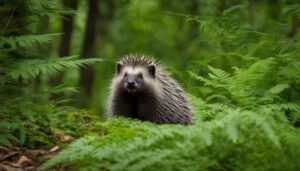Did you know that capybaras, the world’s largest rodents, can be found in the vast Amazon Rainforest?
Yes, capybaras live in the Amazon rainforest, among other wetland habitats across South America, where they primarily eat water plants, grasses, fruit, and tree bark.
These fascinating creatures are more than just oversized gerbils – they play a crucial role in the ecosystem of this unique and biodiverse region.
From their physical characteristics to their social behaviors, capybaras are truly captivating. In this article, we will delve into the world of capybaras, exploring their habitat, their role in the Amazon Rainforest, the threats they face, and how we can observe them responsibly in their natural environment.
Key Takeaways:
- Capybaras, the world’s largest rodents, inhabit the Amazon Rainforest.
- They have unique physical characteristics and social behaviors that make them fascinating to study.
- Capybaras are herbivores, primarily feeding on vegetation found in and around bodies of water.
- These creatures play a significant role in the Amazon ecosystem as prey species and contributors to nutrient cycling.
- Capybaras face threats such as habitat loss and hunting, making conservation efforts crucial.
Understanding Capybaras
Capybaras, the world’s largest rodents, are fascinating creatures that can be found in the lush Amazon Rainforest.
These animals have unique physical characteristics and intriguing behaviors that make them a subject of interest for researchers and nature enthusiasts alike.
Let’s delve into the physical characteristics and behavior of capybaras to gain a better understanding of these captivating creatures.
Physical Characteristics and Behavior of Capybaras
Capybaras possess several distinctive physical features that set them apart from other rodents.
One notable characteristic is their large size, with adults reaching an average weight of 100 pounds and a length of 4 feet.
Their round bodies, short legs, and small heads contribute to their unique appearance. Capybaras also have webbed feet, which allow them to be semi-aquatic animals.
Behaviorally, capybaras are highly social animals that live in large groups called “herds” or “troops.” These herds can consist of up to 100 individuals and are typically led by a dominant male.
Capybaras engage in social grooming, often seen napping in groups and swimming together, which reinforces their strong social bonds.
These social behaviors are a vital part of their daily lives and contribute to their overall well-being.
The Diet of Capybaras
As herbivores, capybaras have a varied diet primarily composed of vegetation. Their diet consists of various types of grasses, aquatic plants, and even tree bark.
They graze on the lush vegetation found near bodies of water, which provides them with the necessary nutrients to thrive in their environment.
The semi-aquatic nature of capybaras also plays a role in their diet. These animals are known to be excellent swimmers and often submerge themselves in water to find aquatic plants to feed on.
Their ability to consume both land-based vegetation and aquatic plants allows them to adapt to different ecological niches within the Amazon Rainforest.
Capybaras and Their Habitat

Capybaras are fascinating creatures that are well-adapted to their natural habitat in the Amazon Rainforest.
They thrive in diverse environments, but their preferred habitat includes bodies of water such as swamps, marshes, and riverbanks.
These water sources are essential for capybaras as they rely on them to keep their skin moist and regulate their body temperature.
These semi-aquatic rodents enjoy the lush vegetation surrounding their habitat, which provides them with an abundant food supply.
Capybaras graze on various plants, including aquatic plants and grasses, making their natural habitat in the Amazon Rainforest the perfect location to thrive.
The Natural Habitat of Capybaras
The Amazon Rainforest serves as the primary natural habitat for capybaras. With its vast area and rich biodiversity, the Amazon provides the ideal environment for these gentle creatures to roam freely.
Its dense forests and abundant water sources offer the perfect balance of shelter and sustenance for capybaras.
In the Amazon Rainforest, capybaras can be found in various regions across Central and South America, including Brazil, Peru, and Venezuela.
Their adaptable nature allows them to thrive in different habitats within the Amazon, such as flooded forests, grasslands, and even near human settlements.
Are Capybaras Native to the Amazon Rainforest?
Capybaras are native to Central and South America, including the Amazon Rainforest. While they are primarily associated with the Amazon, they can also be found in other regions of their native range.
These regions include the Pantanal wetlands in Brazil, the Llanos grasslands in Venezuela and Colombia, and the marshes of Paraguay and Argentina.
The Role of Capybaras in the Amazon Ecosystem

Capybaras play a significant role in maintaining the delicate balance of the Amazon ecosystem.
As an important prey species, they serve as a vital link in the food chain, sustaining predators such as jaguars, pumas, and caimans.
Their large population size and herbivorous diet make them a plentiful and accessible food source for these apex predators.
However, capybaras’ ecological importance extends beyond being prey. These magnificent creatures contribute to nutrient cycling by grazing on vegetation and depositing nutrient-rich feces back into the environment.
This process helps enrich the soil and promote the growth of vegetation, thus shaping the diverse plant communities found in the rainforest.
Furthermore, capybaras play a crucial role in seed dispersal. As they move through the rainforest, they consume fruits and seeds, which later pass through their digestive system intact.
By distributing these seeds across different areas of the forest through their droppings, capybaras help propagate plant species, contributing to the overall biodiversity of the Amazon.
Threats to Capybaras in the Amazon

Capybaras, like other wildlife, face significant threats in their natural habitat, predominantly as a result of human activities. These threats pose a serious risk to capybara populations in the Amazon Rainforest.
Human Impact on Capybara Populations
Habitat loss is one of the main contributing factors to the decline in capybara populations. As the Amazon Rainforest experiences deforestation for agricultural expansion, capybaras lose their habitat and struggle to find suitable areas to thrive.
In addition to habitat loss, capybaras are also hunted for their meat, fur, and body parts, posing a significant threat to their survival.
This unsustainable hunting disrupts the delicate balance of the capybara population and has a profound impact on their overall numbers.
Furthermore, the illegal pet trade poses another danger to capybaras in the Amazon. Many individuals are captured from the wild and sold as pets, leading to further declines in their populations.
Conservation Efforts for Capybaras
Recognizing the importance of capybaras in the Amazon Rainforest ecosystem, several conservation initiatives are working tirelessly to protect this unique species and their habitat.
Conservation efforts focus on raising awareness about capybara threats and promoting sustainable practices to mitigate their impact.
This includes advocating for responsible land use practices to prevent further habitat loss and implementing regulations to combat illegal hunting and the pet trade.
Furthermore, conservation organizations collaborate with local communities, policymakers, and scientists to develop strategies for capybara conservation.
These efforts aim to ensure the survival and well-being of capybaras in the Amazon for present and future generations.
Observing Capybaras in the Amazon

For wildlife enthusiasts and nature lovers, observing capybaras in their natural habitat can be a thrilling experience.
These unique creatures, known for their large size and semi-aquatic nature, can be found in the vast and captivating Amazon Rainforest.
Spotting capybaras in their natural habitat requires knowledge of their preferred regions within the rainforest, increasing the chances of witnessing their fascinating behaviors and interactions with their environment.
Where to Find Capybaras in the Amazon Rainforest
To increase your chances of capybara spotting, head to the various water sources in the Amazon Rainforest.
Capybaras are often found near swamps, marshes, and riverbanks, where they seek refuge and regulate their body temperature.
These areas provide ample vegetation for their diet and offer a favorable environment for these fascinating creatures to thrive.
Keep your eyes peeled while exploring these regions for a chance to witness capybaras in their natural habitat.
Responsible Wildlife Watching
When observing capybaras in the Amazon Rainforest, it is essential to practice responsible wildlife watching.
Guidelines to ensure the well-being of capybaras and their ecosystem:
- ✅ Keep a respectful distance: Avoid getting too close to capybaras to prevent disturbing their natural behaviors and causing them stress.
- ✅ Do not feed or touch capybaras: Feeding human food to capybaras can harm their health and disrupt their natural diet. Likewise, touching them can transmit diseases or disrupt their social interactions.
- ✅ Stay quiet and still: To minimize disturbance, maintain a quiet and calm presence while observing capybaras. Avoid making loud noises or sudden movements that may startle or frighten them.
- ✅ Do not litter: Dispose of waste properly and respect the natural environment by not leaving any trash behind. This helps preserve the integrity of the ecosystem.
- ✅ Follow the guidance of local guides or tour operators: If you choose to join a guided tour, ensure that your tour operator follows ethical practices and respects the welfare of the wildlife.
By observing capybaras responsibly, you contribute to their conservation and the preservation of their natural habitat in the Amazon Rainforest.
Remember that these incredible creatures are part of a delicate ecosystem, and our actions can have a lasting impact on their well-being.
Conclusion
In conclusion, capybaras are fascinating animals that play a vital role in the Amazon Rainforest ecosystem.
Their unique characteristics, such as their large size and semi-aquatic nature, make them truly captivating creatures to study and observe.
However, capybaras face various threats, including habitat loss, hunting, and illegal pet trade. It is crucial that we take immediate action to protect and conserve these remarkable animals.
By deepening our understanding of capybaras and their habitat, we can raise awareness about their ecological importance and the need for their preservation.
Additionally, responsible wildlife watching practices can ensure that capybaras can thrive undisturbed in their natural environment.
Let us join hands in safeguarding capybaras and protecting the Amazon Rainforest, ensuring that these incredible creatures continue to enrich our world for generations to come.
Frequently Asked Questions
Q: Do Capybaras live in the Amazon rainforest?
A: Yes, capybaras live in the Amazon rainforest among other wetland habitats across South America.
Q: What do capybaras eat in the Amazon rainforest?
A: In the Amazon rainforest, capybaras primarily eat water plants, grasses, fruit, and tree bark.
Q: How do capybara survive in the Amazon rainforest?
A: Capybaras survive in the Amazon rainforest by adapting to aquatic environments, feeding on abundant vegetation, and using water as a refuge from predators.
Q: What plants do capybaras eat in the rainforest?
A: Capybaras in the rainforest eat a variety of plants including aquatic plants, grasses, and sometimes fruit and bark from trees.
Q: What is the capybara habitat and food?
A: Capybaras inhabit wetlands, including riverbanks, marshes, and swamps, and their diet consists of water plants, grasses, and sometimes fruit.
Q: Do jaguars eat capybaras in the Amazon rainforest?
A: Yes, jaguars are one of the natural predators of capybaras in the Amazon rainforest.




